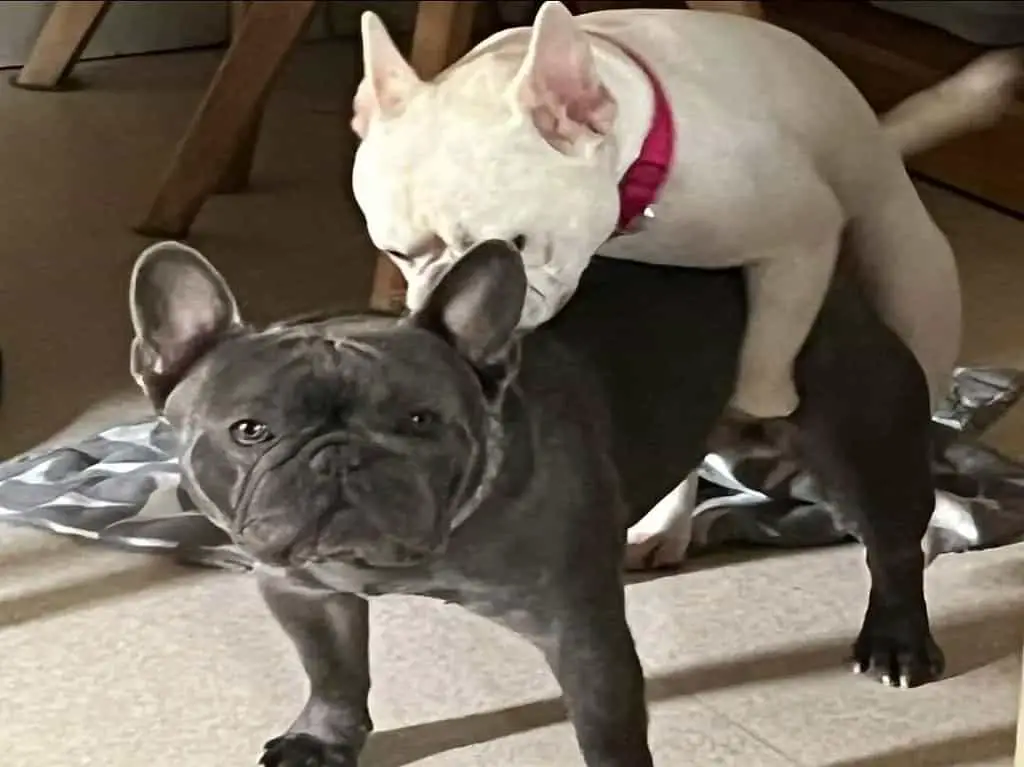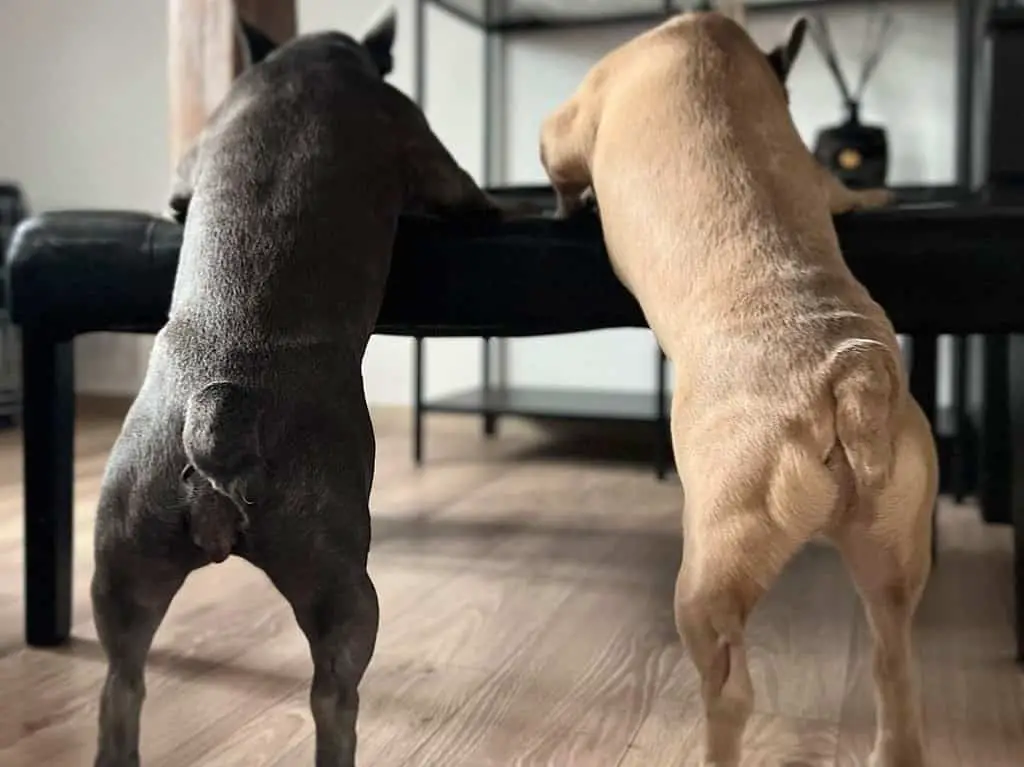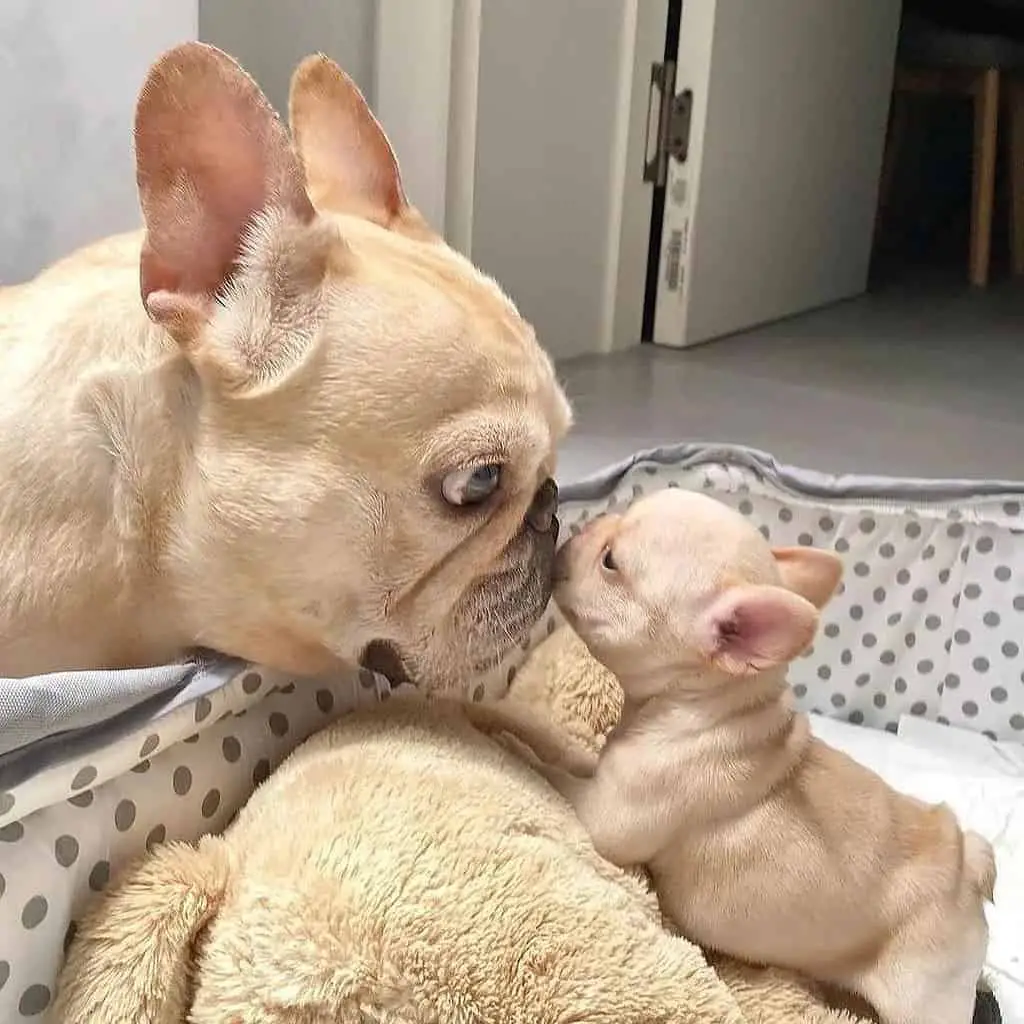Is your French Bulldog already at the ideal age to get pregnant? We bet you can’t wait to meet those tiny Frenchies with round eyes and squished faces. We’re excited for you too!
But can we be totally honest with you? Getting your female Frenchie knocked up is not as easy as you think. If you had your other dogs bred easily before, consider the process a totally different experience this time. Why is this so?
Here’s the bottom line: their unique anatomy may hinder successful reproduction. That’s right; French Bulldogs may fall short when it comes to their mating and natural breeding abilities.
Read on as we answer the most important question — Can French Bulldogs breed naturally?

Overview of the French Bulldog Breed
The French Bulldog, or Frenchie, has become sought after internationally due to its distinct features. They have an appearance that includes bat-shaped ears, a small body frame, and cute facial expressions that make them attractive companions.
French Bulldogs are very solid and toned dogs, typically standing between 11 to 13 inches and weighing 16 to 28 pounds. Perhaps the breed’s most distinctive feature is their iconic “bat” ears, which have a broad base set prominently on top of the head. In addition, their round eyes and slightly pushed-in muzzle create an empathetic aura often found highly endearing.
Frenchies have loving dispositions and tight connections to their owners. They crave attention from humans and tend to develop strong bonds with them. Furthermore, they retain a demeanor of cheerfulness which can bring joy to those around them. Not only that, but their adaptive characteristics permit these dogs to adjust effortlessly to diverse lifestyles and tolerate kids.
French Bulldogs tend to demonstrate a gentle and polite demeanor but may be hesitant or even self-willed in learning commands. Hence, this eager-to-please breed should be taught with patience and reinforcements that bridge the gap between desired behavior and results. In addition, socializing them early on in life helps them become mature dogs with self-confidence.
These dogs have moderate exercise requirements, including daily walks and play sessions. Nonetheless, they are not overly demanding physical activity-wise. As they have a brachycephalic (short-faced) structure, this breed is more sensitive to heat and may suffer from increased exposure to it or strenuous exercises. Consequently, owners must be aware of their activity levels to ensure correct rest intervals and adequate water intake during the day.
As for their grooming needs, these dogs are low shedding, so minimal grooming is expected. To maintain their coat quality and reduce shedding, regular brushing is recommended. These pups come in various colors, including brindle, fawn, cream, and sometimes striking patterns or markings in their body.
Like other purebreds, French Bulldogs can suffer from particular health problems due to their brachycephalic anatomy – shortened skull, flat face, and slightly obstructed airways. This can lead to difficulty breathing during hot weather and intense exercise. These pets also commonly inherit hip dysplasia, patellar luxation, and spinal deformities that require vet treatment.
Can French Bulldogs Breed Naturally?
Let’s get to the point: Reproduction through natural mating can be complicated for French Bulldogs due to their unique anatomy.
The short and solid physique of males often inhibits successful mounting, while the females may experience difficulties properly positioning themselves to allow for conception. These factors make the usually basic task of reproduction in French Bulldogs more complicated and difficult.
Nonetheless, it is possible for them to reproduce successfully with the help of artificial insemination.
Other Physical Limitations and Health Concerns
Brachycephalic Anatomy
The physical build of certain dog breeds, including French Bulldogs, is often referred to as brachycephalic anatomy, characterized by a short skull, flat face, and restricted airways.
Frenchies, with short muzzles and compressed nasal passages, have difficulty breathing correctly, causing additional stress when engaged in physical activity. As a result of the compromised respiratory system, breeding presents certain risks, as the energy needed for respiration while mating can be draining on the dog’s body.
As we have noted, male French Bulldogs struggle to perform the usual actions required for mating due to this reduced physical capability. Not only does their short size make it tough for successful insemination of partners, but females are also confronted with constricted birth canals and decreased pelvic size, making giving birth difficult and even possibly fatal. Let’s discuss this shortcoming more in the next section.
Narrow Hips and Pelvis
The structure of a French Bulldog’s hips can get in the way of successful mating, as the narrowness may prevent optimal alignment for sex. This can cause issues in successfully impregnating a female and thus should be considered when attempting to mate them.

Additionally, a narrow pelvis generally means less room for the puppies to pass through before birth. This can often lead to dystocia, which is prolonged and difficult labor. In many cases, veterinary intervention may be required, with assistance such as a cesarean section necessary for the puppies’ successful delivery.
Due to their brachycephalic features, French Bulldogs are burdened with potential health issues, including obstructed airways from narrowed nostrils, an elongated soft palate, and a constricted trachea. Coupled with the breed’s limited pelvis size, there is a possibility of birthing Frenchie pups with birth defects.
Heat Intolerance
The inability of French Bulldogs to efficiently pant is the primary cause of their heat intolerance. Panting increases airflow, which permits moisture evaporation from the respiratory tract; a process vital to thermoregulation in dogs. Unfortunately, restricted airways hinder such action and limit their capacity to regulate body temperature in high-temperature settings.
Another common reason that further weakens the French Bulldog’s ability to regulate its body temperature in hot environments is obesity. The additional layer of fat on these breeds obstructs heat dissipation, increasing their susceptibility to overheating. This is particularly concerning as this breed seems to be prone to obesity more than other breeds.
Evidently, French Bulldogs have significant difficulties with heat tolerance; this is especially so during breeding. Since mating involves physical effort and metabolic activity, it intensifies their body temperature. Add to that the fact that they have diminished air circulation and cooling capabilities, and the act of natural breeding swiftly becomes challenging for them. The risk of overheating could lead to serious health implications both for male and female dogs.
Artificial Insemination As An Alternative Breeding Method For Frenchies
Through artificial insemination, physical limitations are no longer an obstacle to successful reproduction. By doing this, there is a lower risk of injuries or complications due to difficult mating attempts.
Artificial insemination starts with retrieving semen from a male French Bulldog, which is usually achieved by stimulating the male manually.
The female French Bulldog must be conditioned for reproductive insemination as part of the alternative breeding process. Considerable planning is necessary to establish the most effective moment, depending on analyzing her estrus cycle and administering hormone tests. A veterinarian will determine when it is ideal for the mating procedure, utilizing progesterone levels and other physiological cues to indicate ovulation readiness.
The insemination of the female dog should occur when the situation is ideal, using a small, clean pipe to inject the semen into her uterus near the entrance of her cervix.
In addition, artificial insemination provides breeders with heightened odds of successful breeding for French Bulldogs. The duration and synchronization of the reproductive cycle of both male and female dogs are not always certain via natural mating, which may result in unsuccessful mating attempts. Artificial insemination permits complete control over when insemination will occur, ensuring it takes place during the most fertile window of the female’s reproductive system. This notably improves the chances for successful breeding.
Although artificial insemination requires technical expertise, it enables breeders to effectively select and preserve desirable genetic traits in French Bulldogs. Breeders can use semen from studs with desirable characteristics and healthy backgrounds despite their physical unavailability for traditional mating. This way, the selection process can be refined to ensure desirable traits are passed into the litter.
C-Section Delivery For French Bulldog Puppies
French Bulldogs possess anatomical features that create complications during labor. Due to their narrow hips, their puppies can struggle to pass through the birth canal. Combined with usually large-sized heads in puppies, dystocia (which we previously described as the inability of puppies to be born naturally) is a high-risk occurrence in this breed. This brings considerable suffering to both mother and her offspring.
This procedure involves a surgical delivery of puppies from the mother’s uterus while professional medical personnel cautiously observe her vitals and administer anesthesia to ease pain or discomfort. Promptly after successful delivery, puppies receive examinations and required treatments should any health concerns arise.
Comparatively, a c-section delivery provides numerous benefits over traditional birthing. By mitigating the risk posed by dystocia, this procedure ensures a safe labor and birth process for the mother and her puppies. In addition, it allows medical professionals to thoroughly evaluate each puppy soon after birth, recognizing any ailments that may need attention right away. For breeders especially, C-sections enable them to schedule deliveries more precisely.
But note: Performing a C-section is an intense medical procedure with potential risks, including infection, heavy blood loss, and allergies to anesthesia. Moreover, the mother may require more stabilization time than a vaginal birth and extra assistance during recovery afterward. To ensure full recoveries, breeders and owners must closely attend to their veterinarian’s instructions regarding post-operative care.
Importance Of Responsible Breeding Of French Bulldogs
Frenchie Breeders should strive to exercise responsible breeding practices, prioritizing quality over quantity.

The decision to breed French Bulldogs should not be motivated by monetary gain; instead, it should stem from genuine love and concern for the breed. Breeding done responsibly considers the dog’s health, disposition, and overall quality of life. A reputable breeder ensures their dogs receive necessary vet care, sufficient exercise and nutrition, and ample socialization in a welcoming home environment.
They also assess potential owners to ensure the puppies are placed in homes with people who understand and can commit to meeting the requirements of responsible pet ownership specific to the breed. Consequently, this practice helps reduce abandonment, mistreatment, and dogs ending up in shelters or rescue groups.
French Bulldogs are not for the uninitiated or otherwise unknowledgeable owner, as they require specific care to remain healthy. Before committing, potential pet owners should research several studies regarding the breed’s physical attributes, health risks, and needs. Otherwise, when challenges arise involving conditions like respiratory illness and heat intolerance – shared in this breed – it may lead to them being abandoned by ill-informed individuals who did not proactively educate themselves on these matters.
Conclusion
Can French Bulldogs breed naturally? The answer is yes!
But here’s the kicker: Due to French Bulldogs having brachycephalic skulls, narrow pelvises, and weaker respiratory systems, they often face difficulties when attempting to reproduce via natural mating. To combat this, breeders commonly utilize artificial insemination as a more reliable means of reproduction.
Frequently Asked Questions
What is the recommended age for French Bulldogs to start breeding?
It is essential to consider the risks when choosing a time for a French Bulldog to begin breeding. While the recommended age varies, it is typically best to wait until the dog reaches two years of age. Reproducing too early can be detrimental to both mother and puppies alike; sufficient maturation before breeding will support proper physical and mental development while decreasing the chances of issues occurring during pregnancy and delivery.
Breeding French Bulldogs before two years of age may lead to puppies with medical complications or delays in development. By following the recommended wait period, breeders can guarantee that the dog is functioning at its peak level of health and has undergone the necessary health screening, minimizing the transmission of genetic disorders to the offspring.
What is the average litter size for French Bulldogs?
On average, a French Bulldog litter comprises two to four puppies. Several influences, such as the age and health of the mother dog, heredity, and nutritional care provided during pregnancy, can impact the size of the litter. Moreover, breeders may employ selective breeding practices to modify litter sizes.
Can French Bulldogs mate with other dog breeds?
French Bulldogs’ small size and body shape pose a challenge during mating. Furthermore, Frenchies are prone to specific health issues. Crossbreeding with other breeds of the exact nature could potentially aggravate these issues further.
To ensure the well-being and good condition of French Bulldogs are not compromised, responsible breeders should not intentionally crossbreed them with other dogs but instead practice selective breeding, aiming to improve the breed’s health and temperament through artificial insemination.




